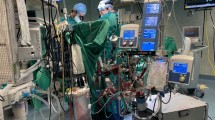Summary
Introduction: Avoidance of extracorporeal circulation during beating heart surgery (OP CAB = Off-Pump Coronary Artery Bypass Surgery) for aortocoronary bypass grafting (ACBG) is gaining increasing importance in modern cardiac surgery. With the development of new mechanical stabilization devices, the revascularization of the posterior wall of the heart and the distal rith coronary artery became feasable. Especially high-risk patients with multiple risk factors for open heart surgery will profit from this approach, because the negative effects of the extracorporeal circulation are avoided.
Methods: From 7/97 until 12/99 a total of 158 patients with ultivessel-coronary artery disease were operated on the beating heart. In the same time course, a total of 2869 patients were operated conventionally using the extracorporeal circulation as a standard procedure.
Results: Due to patient selection, the two groups differ in the preoperative data concerning previous neurologic deficits. None of the patients in th OP CAB group suffered a permanent neurologic deficit after the operation, whereas in the CAB group the rate of stroke was 1.3%. The rate of temporary neurologic deficits, such as TIA (temporary ischemic attack) or PRIND (prolonged reversible neurologic deficit), was higher in the OP CAB group due to patient selection. No surgially associated aortic dissection was seen in the OP CAB group.
Conclusions: This and other studies have shown the effectiveness of OP CAB surgery concerning perioperative complications and survival rates. Especially high-risk patients with multiple risk factors for a cardiac operation profit from a beating-heart operation avoiding extracorporeal circulation. The question in how far the higher rate of reoccuring angina and the larger number of interventional treatments in OP CAB patients reported in the literature are due to the learning curve remains unanswered. Long-term studies will show whether the result of beating heart surgery is as good as the result of conventional “on-bypass” surgery.
Zusammenfassung
In der neuzeitlichen Herzchirurgie nimmt die Bypasschirurgie am schlagenden Herzen unter Vermeidung der extrakorporalen Zirkulation einen zunehmenden Stellenwert ein. Durch die Entwicklung neuer mechanischer Stabilisationssysteme wurde es möglich, auch Gefäßprovinzen der Hinterwand und der distalen rechten Kranzarterie zu erreichen. Insbesondere Hochrisikopatienten mit multiplen Risikofaktoren profitieren, da die negativen Effekte der extrakorporalen Zirkulation ausgeschaltet werden können, von der Revaskularisation am schlagenden Herzen.
Methodik: Es wurden 158 Patienten mit einer koronaren Mehrgefäßerkrankung in das OP CAB-Verfahren (“off-pump-coronary-artery-bypass”) eingeschlossen. Im gleichen Zeitraum wurden 2869 Ptienten unter Zuhilfenahme der Herz-Lungen-Maschine bypasschirurgisch versorgt.
Ergebnisse: Die Patientenkollektive unterscheiden sich in den präoperativen Daten durch eine erhöhte Anzahl von Patienten mit präoperativ stattgehabten manifesten neurologischen Defiziten in der OP CAB-Gruppe. Trotzdem kam es in der OP CAB-Gruppe zu keinem Auftreten eines permanenten neurologischen Defizits, wohingegen in der Gruppe mit Herz-Lungen-Maschine 1,3% der Patienten ein permanentes neurologisches Defizit erlitten. Die Anzahl der temporären neurologischen Defizite wie TIA (“temporary ischemic attack”) und PRIND (“prolonged reversible neurologic deficit”) war aufgrund der Auswahl des Patientenkollektivs in der OP CAB-Gruppe erhöht. Es kam zudem aufgrund des Operationsverfahrens zu keiner chirurgisch ausgelösten Aortendissektion in der OP CAB-Gruppe.
Schlussfolgerungen: Die hier vorliegende Untersuchung und bereits durchgeführte Studien zeigen, dass die Effektivität der Herzoperation im Hinblick auf perioperative Komplikationen sowie Überlebensraten nachgewiesen ist. Insbesondere Hochrisikopatienten mit multiplen Risikofaktoren profitieren von der Revaskularisation am schlagenden Herzen. Inwieweit Hinweise auf eine erhöhte Rate von rezidivierenden Angina pectoris und vermehrten interventionellen Maßnahmen in der Literatur in der OP CAB-Gruppe auf eine intiale Lernkurve zurückgeführt werden können, kann derzeit nicht beantwortet werden. Es bleibt Langzeitstudien überlassen, eine dauerhaften Erfolg der Koronarrevaskularisation am schlagenden Herzen nachzuweisen.
Similar content being viewed by others
Author information
Authors and Affiliations
Rights and permissions
About this article
Cite this article
Ennker, J., Bauer, S., Buhmann, U. et al. Mehrfachmyokardrevaskularisation am schlagenden Herzen – Risiken, Nutzen und Chancen. Z Kardiol 89 (Suppl 7), 37–46 (2000). https://doi.org/10.1007/PL00022884
Published:
Issue Date:
DOI: https://doi.org/10.1007/PL00022884




